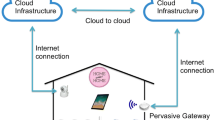Abstract
In the near future, we will see dramatic changes in computing and networking hardware. A large number of devices (e.g., phones, PDAs, even small household appliances) will become computationally enabled. Micro/nano sensors will be widely embedded in most engineered artifacts, from the clothes we wear to the roads we drive on. All of these devices will be (wirelessly) networked using Bluetooth, IEEE 802.15 or IEEE 802.11 for short range connectivity creating pervasive environments. In this age where a large number of wirelessly networked appliances and devices are becoming commonplace, there is a necessity for providing a standard interface to them that is easily accessible by any user. This paper outlines the design of Centaurus, an infrastructure for presenting services to heterogeneous mobile clients in a physical space via some short range wireless links. The infrastructure is communication medium independent; we have implemented the system over Bluetooth, CDPD and Infrared, three well-known wireless technologies. All the components in our model use a language based on Extensible Markup Language (XML) for communication, giving the system a uniform and easily adaptable interface. Centaurus defines a uniform infrastructure for heterogeneous services, both hardware and software, to be made available to diverse mobile users within a confined space.
Similar content being viewed by others
References
K. Arnold, A. Wollrath, B. O'sullivana, R. Scheifler and J. Waldo, The Jini Specification (Addison-Wesley, Reading, MA, 1999).
M. Blaze, J. Feigenbaum, J. Ioannidis and A. Keromytis, The role of trust management in distributed systems, in: Secure Internet Programming, LNCS Vol. 1603 (Springer, Berlin, 1999) pp. 185–210.
M. Blaze, J. Feigenbaum and J. Lacy, Decentralized trust management, in: IEEE Proceedings of the 17th Symposium (1996).
Bluetooth, http://www.bluetooth.com
M. Esler, J. Hightower, T. Anderson and G. Borriello, Next century challenges: Data-centric networking for invisible computing, in: Fifth Annual ACM/IEEE International Conference on Mobile Computing and Networking (MobiCom'99) (ACM Press, August 1999) pp. 256–262.
S.D. Gribble et al., The Ninja architecture for robust Internet-scale systems and services, Computer Networks 35(4) (1999) 473–497.
Hewlett-Packard Company, Internet business solutions: E-Speak, http://www.e-speak.hp.com
T. Hodes and R.H. Katz, A document-based framework for Internet application control, in: Second USENIX Symposium on Internet Technologies and Systems (USITS'99) (October 1999).
T.D. Hodes, R.H. Katz, E. Servan-Schreiber and L. Rowe, An architecture for a secure service discovery service, in: 3rd ACM/IEEE MobiCom, Budapest, Hungary (September 1997).
I. Horrocks et al., DAML +OIL language specifications (2001) http://www.daml.org/2000/12/daml+oil-index
Infra-red, http://www.irda.org
F. Kon, C.K. Hess, M. Roman, R.H. Campbell and M.D. Mickuna, A flexible, interoperable framework for Active spaces, in: OOPSLA' 2000 Workshop on Pervasive Computing, Minneapolis (October 16, 2000).
D. Norman, The Invisible Computer (MIT Press, 1998).
S.R. Ponnekanti, B. Lee, A. Fox, P. Hanrahan and T. Winograd, ICrafter: A service framework for ubiquitous computing environments, in: Ubicomp 2001 (2001).
M. Roman and R.H. Campbell, Gaia: Enabling Active Spaces, in: Proceedings of the 9th ACM SIGOPS European Workshop, Kolding, Denmark (September 2000).
M. Satyanarayanan, Pervasive computing: Vision and challenges, IEEE Communications (2001).
Stanford Interactive Workspaces Project, http://graphics.stanford.edu/projects/iwork/
M. Taylor, W. Waung and M. Banan, Internetwork mobility: The CDPD approach, Prentice Hall professional technical reference, September 1996 (1999).
J. Undercoffer, A. Cedilnik, F. Perich, L. Kagal and A. Joshi, A secure infrastructure for service discovery and management in pervasive computing, Mobile Networks and Applications (2002).
M. Weiser, The computer for the twenty-first century, Scientific American (September 1991) 94–100.
Author information
Authors and Affiliations
Rights and permissions
About this article
Cite this article
Kagal, L., Korolev, V., Avancha, S. et al. Centaurus: An Infrastructure for Service Management in Ubiquitous Computing Environments. Wireless Networks 8, 619–635 (2002). https://doi.org/10.1023/A:1020385804671
Issue Date:
DOI: https://doi.org/10.1023/A:1020385804671




